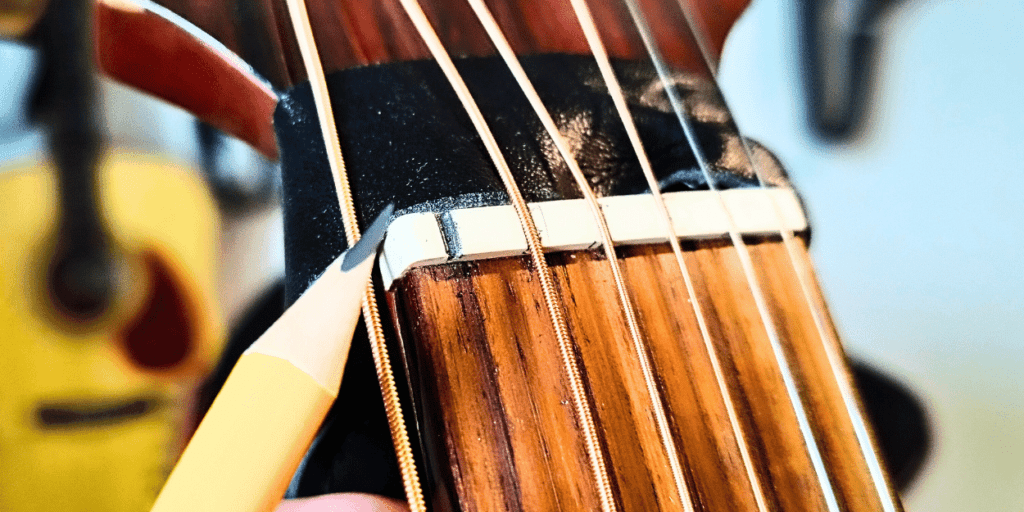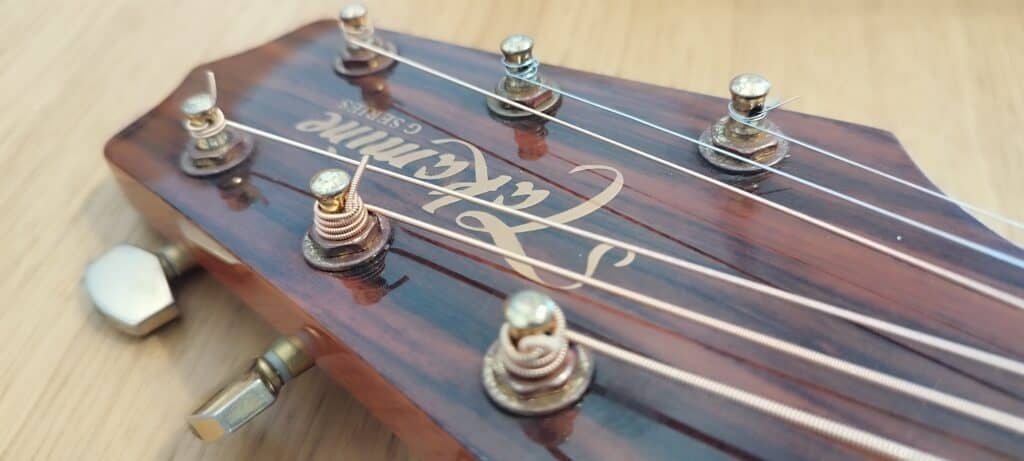One of the biggest problems a beginner faces when playing guitar is keeping it in tune. What doesn’t make the task easier is most starter guitars don’t have very good tuners and aren’t properly intonated. For shame, manufacturers! Regardless, there are a few tricks you can do if your guitar won’t stay in tune and to keep your guitar in tune no matter what you throw at it.

Table of Contents
What to do When A Guitar Won’t Stay In Tune?
There are a few different things you should try to keep your guitar in tune. Some require altering your guitar, but some are just practices you should adopt whether or not your guitar has tuning stability issues.
Apply Graphite on The Nut
You probably think I’m joking. I thought so, too, the first time I heard about it. But graphite is an excellent Lubricant. It’s so good that guitar manufacturers started producing nuts and bridges using graphite to prevent string slippage. This proves how effective this method of keeping your guitar in tune is. And luckily, Graphite is so common that you probably even have some at home.
Take a number 2 pencil. There are two points on the string where you should apply. The slotted nut, which is where the strings meet the guitar near the headstock. Your nut will be white or black and is literally a row of six slots at the top of the fretboard. Take the strings off the guitar and use the number 2 pencil to rub some graphite in there. The other place you should rub the pencil is the bridge. The bridge is the saddle, where the strings come out from. Take a look at where the strings meet the bridge, and then go ahead and apply a good amount of graphite to it. This is one trick that you should pretty much always use. There’s no reason not to use it, so go ahead. Just be sure not to apply too much graphite, or the string will have no give at all and will probably snap the second you try to bend it.
Graphite Nut
In addition to helping guitar stay in tune, Graphite nuts actually sound a lot better than the plastic nuts found on most guitars. Switching to a Graphite nut (a saddle) will make your acoustic guitar sound better, and will drastically improve an electric guitar’s sound.

Tune Upwards
Second, always tune upwards. That is, don’t tune from A# to A. Tune from G# to A. The reason being, if you tune downwards, then the string is ”loose” and is ready to slip more. If you tune upwards, the string is at its highest point of tension and is more likely to stay in place. Definitely always do this no matter what.
Don’t Over-Tighten Your Strings
Third, leave just a little bit of string loose as you tune a string for the first time. One thing many beginners do is tighten the string as tight as possible before turning the tuner. This is a bad idea, and it should be obvious why. If you tighten an already extremely tight string, it’ll have no give at all. This increases the chances that it will snap, and also increases the chance that will be more likely to slip out of tune as the string surface area will be stretched far too much than it can handle.
A Luthier’s Knot
A luthier’s knot, in case you have never heard of it, is a simple knot you tie around the tuning post when you restring your acoustic or electric guitar.
It’s quite simple to do and will ensure your guitar won’t lose its tuning by securing the string to the posts.

Tuning Stability Misconception
Even though some things can surely help with keeping your guitars in tune, some popular recommendation won’t help your guitar stay in tune one bit.
Installing Locking Tuners for Tuning Stability
Personally, I switch to locking tuners whenever I have a reason to. They are extremely convenient when changing strings, but unlike popular belief, they are not meant to keep your guitar in tune.
If you know how to restring your guitar properly, locking tuners are only a matter of convenience. They save you the step of securing the string to the pole, but they don’t do that better than you should’ve. Each type of tuner has a different method, but every single type of tuner is capable of keeping tune.
If you want to save a few minutes every time you change your strings, Grover and Gotoh make some of the best locking tuners, but they come at a cost. I saw many recommendations for Sperzel tuners but never tried them myself. Guyker is a relatively cheap brand I tried recently and really liked, so you are not short of options here.
Finishing Thoughts
Now, if your guitar won’t stay in tune after trying all of these, I suggest you take it to a professional, or set it up by yourself and intonate it properly, which is something you should do every once in a while anyway.
Thanks for reading. You should be able to stay in tune quite easily now. Good luck!
If you liked this post, check out other guitar maintenance related posts.